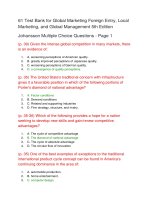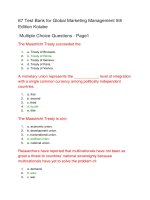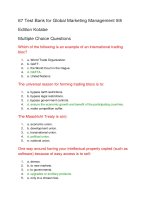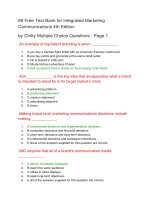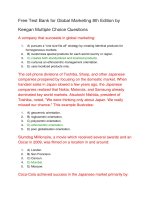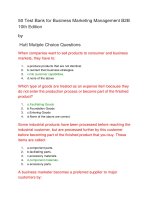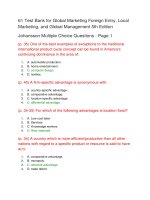99 test bank for global marketing management 5th edition kotabe
Bạn đang xem bản rút gọn của tài liệu. Xem và tải ngay bản đầy đủ của tài liệu tại đây (118.83 KB, 28 trang )
99 Test Bank for Global Marketing Management 5th
Edition Kotabe
Multiple Choice Questions - Page1
The effect of a monetary union is that members:
1.
a. can buy goods from one another.
2.
b. refuse to buy goods from nonmembers.
3.
c. switch to a common currency and a central bank.
4.
d. give up all sovereignty.
5.
e. no longer recognize national boundaries.
An example of a free trade area would be:
1.
a. the European Union.
2.
b. the Soviet Union.
3.
c. the United Kingdom.
4.
d. NAFTA.
5.
e. the United Nations.
One difference between a customs union and a free trade area is that the
customs union:
1.
a. adds external tariffs to nonmember countries.
2.
b. adds higher taxes to its consumers.
3.
c. refuses to import from nonmember nations.
4.
d. demands that a common currency be used among members.
5.
e. requires that member countries align themselves politically.
The principle goal of a political union is that it:
1.
a. can buy goods from one another.
2.
b. can refuse to buy goods from nonmembers.
3.
c. can switch to a common currency and a central bank.
4.
d. gives up all sovereignty among individual members.
5.
e. no longer recognizes national boundaries.
The universal reason for forming trading blocs is to:
1.
a. bypass tariff restrictions.
2.
b. bypass legal restrictions.
3.
c. bypass government controls.
4.
d. ensure the economic growth and benefit of the participating countries.
5.
e. make competition suffer.
The World Trade Organization’s (WTO) ninth round of trade talks which
were launched in November 2001 is called:
1.
a. the Doha Round.
2.
b. the Seattle Round.
3.
c. the Geneva Round
4.
d. the New York Round.
5.
e. the London Round.
One hurdle that used to protect information from being acquired easily
was that it was unfungible. Unfungible means:
1.
a. information contained viruses.
2.
b. information was expensive.
3.
c. information could only be processed with proper equipment.
4.
d. information was not for the uninformed.
5.
e. it was difficult to replace one item with another.
____________________ are highly interested in putting strong
international intellectual property laws in place:
1.
a. Developing nations
2.
b. Developed nations
3.
c. Asian countries
4.
d. European countries
5.
e. African countries
The Maastricht Treaty succeeded the:
1.
a. Treaty of Brussels.
2.
b. Treaty of Rome.
3.
c. Treaty of Geneva.
4.
d. Treaty of Paris.
5.
e. Treaty of Vienna.
One way around having your intellectual property copied (such as
software) because of easy access is to sell:
1.
a. demos.
2.
b. to new markets.
3.
c. to governments.
4.
d. upgrades or ancillary products.
5.
e. only to a chosen few.
The primary difference between a common market and a customs union is
that the common market:
1.
a. adopts a common set of external tariffs on nonmembers.
2.
b. eliminates all tariffs.
3.
c. eliminates all trade barriers.
4.
d. removes all restrictions on the flow of capital and labor among member nations.
5.
e. the number of countries involved.
The World Trade Organization (WTO) took effect on:
1.
a. January 1, 1994
2.
b. January 1, 1995
3.
c. January 1, 1996
4.
d. January 1, 1997
5.
e. January 1, 1998
Which of the following is an example of an international trading bloc?
1.
a. World Trade Organization.
2.
b. GATT.
3.
c. the World Court in the Hague.
4.
d. NAFTA.
5.
e. United Nations
An evolving trend in international economic activity is the formation of:
1.
a. multinational advertising agencies.
2.
b. multinational insurance agencies.
3.
c. multinational trading blocs.
4.
d. multinational purchasing agencies.
5.
e. multinational courts.
The World Trade Organization (WTO) was created in the _____________ of
GATT talks---called the Uruguay Round.
1.
a. fifth round
2.
b. sixth round
3.
c. seventh round
4.
d. eighth round
5.
e. ninth round
As of February 28, 2009, the World Trade Organization (WTO) has
_________ member countries.
1.
a. 123
2.
b. 135
3.
c. 142
4.
d. 153
5.
e. 160
In December 1999, WTO launched what would have become the beginning
of a ___________ round of negotiations inaugurated in Seattle,
Washington.
1.
a. fifth
2.
b. sixth
3.
c. seventh
4.
d. eighth
5.
e. ninth
One of the differences between WTO and GATT is that WTO’s dispute
settlement mechanism is:
1.
a. inferior.
2.
b. faster and more automatic.
3.
c. very limited.
4.
d. controlled by the World Bank.
5.
e. controlled by the negotiation section of the United Nations.
The new European currency, the euro, began its circulation in January
________.
1.
a. 1998.
2.
b. 1999.
3.
c. 2000.
4.
d. 2001
5.
e. 2002.
NAFTA is the free trade area among the United States, Mexico, and
______________.
1.
a. Canada
2.
b. Argentina
3.
c. Panama
4.
d. Columbia
5.
e. Brazil
A ___________________ is a formal agreement among two or more
countries to reduce or eliminate customs duties and nontariff trade
barriers among partner countries.
1.
a. trade union
2.
b. regional cooperative
3.
c. customs union
4.
d. common market
5.
e. free trade area
Doha’s Development Agenda (Doha Round) includes new trade talks—an
actions program to resolve developing countries’ complaints about the
implementation of Uruguay Round agreements, and an accord on
____________________________.
1.
a. Trade Related Aspects of Intellectual Property Rights
2.
b. Services Related Aspects of Intellectual Property Rights
3.
c. Regional Related Aspects of Intellectual Property Rights
4.
d. Local Related Aspects of Intellectual Property Rights
5.
e. National Related Aspects of Intellectual Property Rights
UNCITRAL stands for:
1.
a. United Nations Commission on International Trade Law.
2.
b. United Nations Commission on International Trade Limits.
3.
c. United Nations Commission on International Technical Law.
4.
d. United Nations Commission on International Technical Trade.
5.
e. None of the above.
The U.S. government defines the multinational company for statistical
purposes as a company that owns or controls ______________ or more of
the voting securities, or the equivalent, of at least one foreign business
enterprise.
1.
a. five percent
2.
b. ten percent
3.
c. fifteen percent
4.
d. twenty percent
5.
e. twenty-five percent
A monetary union represents the ____________ level of integration with a
single common currency among politically independent countries.
1.
a. first
2.
b. second
3.
c. third
4.
d. fourth
5.
e. fifth
Perhaps the most important accomplishment of the latest GATT round
was the establishment of:
1.
a. the World Trade Organization (WTO).
2.
b. the Asian Development Bank.
3.
c. the World Bank.
4.
d. the International Monetary Fund (IMF).
5.
e. the International Finance Corp. (IFC).
MNCs that become global at their first inception are called:
1.
a. born last firms.
2.
b. born first firms.
3.
c. born again firms.
4.
d. born global firms.
5.
e. none of the above
A ________________ eliminates all tariffs and barriers to trade among
members, adopts a common set of external tariffs on nonmembers, and
removes all restrictions on the flow of capital and labor among member
nations.
1.
a. regional market
2.
b. common market
3.
c. monetary market
4.
d. political market
5.
e. customs market
Researchers have reported that multinationals have not been as great a
threat to countries’ national sovereignty because multinationals have yet
to solve the problem of:
1.
a. demand.
2.
b. size.
3.
c. war.
4.
d. religious conflict.
5.
e. language differences.
The Maastricht Treaty is a(n):
1.
a. economic union.
2.
b. development union.
3.
c. transnational union.
4.
d. political union.
5.
e. national union.
The Free Trade Areas of the Americas (FTAA) was proposed in
__________________.
1.
a. December 1994.
2.
b. December 1995.
3.
c. December 1996.
4.
d. December 1997.
5.
e. December 1998.
The WTO Work Program on _____________________ is in the process of
defining the trade-related aspects of ___________________ that would fall
under the parameters of WTO mandates.
1.
a. business commerce
2.
b. electronic commerce
3.
c. equity commerce
4.
d. network commerce
5.
e. network commerce
The last step of the possible integration forms is the:
1.
a. cartel.
2.
b. common market.
3.
c. monetary union.
4.
d. political union.
5.
e. customs union.
When members of a free trade area add common external tariffs to the
provisions of the free trade agreement, the free trade area becomes a:
1.
a. cartel.
2.
b. common market.
3.
c. monetary union.
4.
d. political union.
5.
e. customs union.
The sovereignty of _______________ will perhaps continue to weaken due
to multinationals and the increasing integration of economies.
1.
a. cities
2.
b. nations
3.
c. regions
4.
d. trading blocs
5.
e. none of the above
With respect to intellectual property rights, an example of an informationrelated product is:
1.
a. computer hardware.
2.
b. an automobile.
3.
c. computer software.
4.
d. jewelry.
5.
e. a new drilling bit.
67 Free Test Bank for Global Marketing Management
5th Edition Kotabe Multiple Choice Questions - Page 2
India’s average growth rate in GDP has been over:
1.
a. 3 percent
2.
b. 5 percent
3.
c. 7 percent
4.
d. 9 percent
5.
e. 10 percent
The International Trade Organization (ITO) was formed after:
1.
a. World War I.
2.
b. World War II.
3.
c. the Korean war.
4.
d. the Vietnam war
5.
e. None of the above.
BEMs stand for:
1.
a. Big Electronic Markets
2.
b. Big Efficient Market
3.
c. Big Effective Markets
4.
d. Big Emerging Markets
5.
e. None of the above
The United States was ranked number _______ on the 2005 Country
Innovativeness Ranking.
1.
a. one
2.
b. two
3.
c. four
4.
d. five
5.
e. six
The World Economic Forum’s Global Competitiveness Report placed two
Asian Tigers (Taiwan and Singapore) among the world’s top ______
economies (along with the Finland, United States, Sweden, Denmark,
Iceland, witzerland, Norway, and Australia).
1.
a. five
2.
b. ten
3.
c. twenty
4.
d. twenty-five
5.
e. thirty
Future trade flows are likely to move how?
1.
a. Among the Triad nations
2.
b. Between the Triad nations and the BEMs
3.
c. Among the BEMs
4.
d. Between the Triad nations and the developing world
5.
e. None of the above
Which nation is the world’s largest exporter?
1.
a. United States
2.
b. China
3.
c. Netherlands
4.
d. Germany
5.
e. Japan
An example of portfolio investment (or indirect investment) in foreign
markets is:
1.
a. production facilities.
2.
b. computers.
3.
c. stocks and bonds.
4.
d. buildings.
5.
e. manufacturing facilities.
Triad regions of the world include:
1.
a. North America, Western Europe and Africa
2.
b. North America, Western Europe and Japan
3.
c. North America, Western Europe and Asia
4.
d. North America, Western Europe and South America
5.
e. North America, Western Europe and China
In the country competitiveness report in 2008/09, three of the top ten
countries are from _________________ countries.
1.
a. South American
2.
b. African
3.
c. Asian
4.
d. Nordic
5.
e. None of the
Trading in foreign currencies has an effect on world trade. For example, a
rise in the value of the local currency due to daily flows vis-à-vis other
currencies makes exports:
1.
a. less expensive.
2.
b. more expensive.
3.
c. come under government control.
4.
d. parallel with imports.
5.
e. be banned.
When GATT was successful in lowering tariff barriers to world trade, many
nations created:
1.
a. cartels.
2.
b. keiretsus.
3.
c. joint ventures.
4.
d. nontariff barriers.
5.
e. boycotts.
Which country consistently achieves the highest growth rates in GDP?
1.
a. United States
2.
b. Germany
3.
c. Japan
4.
d. Vietnam
5.
e. China
The ________________ volume of international trade in currencies
exceeds the annual value of the trade in goods and services.
1.
a. daily
2.
b. weekly
3.
c. monthly
4.
d. annual
5.
e. none of the above
When firms invest in manufacturing and distribution facilities outside their
home countries, they add the stock of
_________________________________.
1.
a. global direct investment.
2.
b. regional direct investment.
3.
c. local direct investment.
4.
d. foreign direct investment (FDI).
5.
e. none of the above.
Which of the following countries is NOT on the list of top 10 exporters?
1.
a. Korea
2.
b. Mexico
3.
c. China
4.
d. United States
5.
e. Both a and b
In general, the larger the country’s domestic economy, the less dependent
it tends to be on exports and imports relative to its ________________.
1.
a. gross domestic product (GDP).
2.
b. gross domestic income.
3.
c. gross domestic spending.
4.
d. gross domestic capital.
5.
e. global domestic knowledge.
According to the textbook, Japan was expected to be ranked number
_______ on the 2005 Country Innovativeness Ranking.
1.
a. one
2.
b. two
3.
c. three
4.
d. four
5.
e. five
New centers of innovative activity include which countries?
1.
a. Ireland
2.
b. Israel
3.
c. Singapore
4.
d. Taiwan
5.
e. All of the above
The World Trade Organization was created in the eighth round of the
GATT talks – called the ________________________ that lasted from 1986
to 1994.
1.
a. Brussels Round
2.
b. Paris Round
3.
c. Morocco Round
4.
d. Paraguay Round
5.
e. none of the above
__________________ refers to investment in foreign countries that are
withdrawable at short notice (such as investment in foreign stocks and
bonds).
1.
a. Direct investment
2.
b. Economic investment
3.
c. International investment
4.
d. Demand investment
5.
e. Portfolio investment
China’s average growth rate in GDP has been over:
1.
a. 2 percent
2.
b. 4 percent
3.
c. 6 percent
4.
d. 8 percent
5.
e. 9 percent
Why did Nokia lose market share in China?
1.
a. Products were outdated
2.
b. Products were too technical
3.
c. Local producers appeared with a cheaper, adequate phone
4.
d. Japan took away their market share
5.
e. None of the above
Global economy is becoming more ____________________.
1.
a. regional.
2.
b. local.
3.
c. isolated.
4.
d. transnational.
5.
e. intertwined.
The main operating principle of the General Agreements of Tariffs and
Trade (GATT) was the concept of normal trade relations (NTR) status,
formerly known as:
1.
a. Early Favored Nation status.
2.
b. Most Favored Nation status.
3.
c. Late Favored Nation status.
4.
d. the World Trade status.
5.
e. the Best Nation status.
Which country has shown the most progress in competitiveness since
2005?
1.
a. Hong Kong
2.
b. Belgium
3.
c. Germany
4.
d. Switzerland
5.
e. Japan
Country competitiveness is not a _____________ thing.
1.
a. fixed
2.
b. moving
3.
c. temporary
4.
d. dynamic
5.
e. none of the above
Which of the top 10 countries in competitiveness does NOT suffer from a
lack of natural resources?
1.
a. Japan
2.
b. Netherlands
3.
c. Switzerland
4.
d. Denmark
5.
e. Canada
With which country does the U.S. have the largest trade deficit?
1.
a. Germany
2.
b. Japan
3.
c. Canada
4.
d. India
5.
e. China
Which of the following countries is not considered to be a big emerging
market?
1.
a. Mexico
2.
b. Brazil
3.
c. Russia
4.
d. India
5.
e. China
In 2004, the global annual trade in goods and services amounted to
$____________.
1.
a. $500 billion.
2.
b. $800 billion.
3.
c. $1 trillion.
4.
d. $8 trillion.
5.
e. $11 trillion.
True - False Questions
Over the Internet, any piece of electronically represented intellectual
property can be instantly copied anywhere in the world.
1.
True
2.
False
The Uruguay Round set up an international body called the World Trade
Organization (WTO).
1.
True
2.
False
FDI in services is controlled by U.S. firms.
1.
True
2.
False
The World Trade Organization (WTO) is a global institutional proponent of
free trade.
1.
True
2.
False
The Triad Regions of the world (North America, Western Europe, and
Japan) collectively produce more than 80 percent of world GDP.
1.
True
2.
False
FTAA stands for Free Trade Area of the Americas.
1.
True
2.
False
In the U.S., the Federal Trade Commission (FTC) is in charge of cases
where entities are trying to mislead the public and commit fraud.
1.
True
2.
False
Regarding regional integration, South American markets are still less
open than those of East Asia.
1.
True
2.
False
A common market eliminates all tariffs and other barriers to trade among
members of the common market.
1.
True
2.
False
As of December 11, 2005, the World Trade Organization (WTO) had 149
member countries.
1.
True
2.
False
Doha Round paved the way for China and Singapore to get full
membership in the WTO.
1.
True
2.
False
GATT’s successor is the World Trade Organization (WTO).
1.
True
2.
False
Regulating international e-commerce does not require cross-border
cooperation.
1.
True
2.
False
One consequence of fungible content, information products, and
electronic networks is an additional assault on the power of national
governments to regulate international commerce.
1.
True
2.
False
The world’s largest exporting country is China.
1.
True
2.
False
The U.S. government defines the multinational corporation for statistical
purposes as a company that owns or controls 60 percent or more of the
voting securities, or the equivalent of at least one foreign business
enterprise.
1.
True
2.
False
A common market and a monetary union are basically the same thing.
1.
True
2.
False
In 2008/2009 Country Competitiveness Report, 5 of the top 10 countries
are Asian countries.
1.
True
2.
False
A free trade area (FTA) is a formal agreement among two or more
countries to reduce or eliminate customs duties and nontariff trade
barriers among partner countries.
1.
True
2.
False
A monetary union represents the fourth level of integration with a single
common currency among politically independent countries.
1.
True
2.
False
The world’s largest importing country is the U.S.
1.
True
2.
False
The main operating principle of the General Agreements of Tariffs and
Trade (GATT) is the concept of the Highly Favored Nation status (HFN).
1.
True
2.
False
Two-thirds of world trade in goods and services is controlled by
multinational companies.
1.
True
2.
False
Currently, Britain and France remain the principal opponents of ceding
any part of the sovereignty of the nation-state to any future political union
in Europe.
1.
True
2.
False
Today, countries have become economically independent.
1.
True
2.
False
NAFTA is the free trade area among Canada, the United States, and Chile.
1.
True
2.
False
Any start-up firm becoming global at its first inception is called as ‘born
again firm’.
1.
True
2.
False
The 1993’s Maastricht Treaty succeeded the Treaty of Brussels.
1.
True
2.
False
